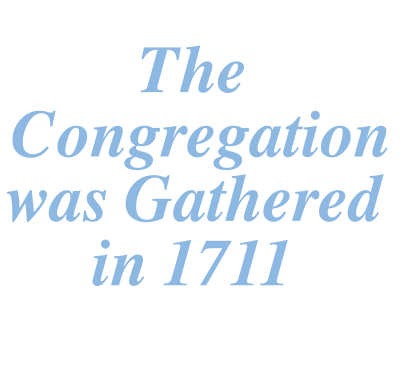-
Our History
-
The history of one Congregational Church, situated in the midst of the Puritans is the history of East Haven and more or less the history of all New England. A church performing its job in its local surroundings epitomizes the general background of New England. In every church there are cycles of great spirit, and then there are also times of low ebb. Old Stone Church stubbornly carries on through highs and lows, sometimes resisting new ideas and changes, and then, when least expected, it moves forward in a spurt of energy and purpose to grow beyond its dreams.
As we Americans know, the original settlers of New England set out on their journey under great hardship to seek religious freedom and to worship as they wished without oppression. So came the Puritans, by way of Boston, to form a theocracy in New Haven in 1638 and in 1644 to East Haven, perhaps before. The Congregational Church is just as its name implies, a church of, about, supported and owned by the congregation or members. Today as in the past, without the support of its members, any Congregational Church dies, and many have. For 300 years the First Congregational Church of East Haven has been the center of family, church and community life. Some of the history follows, but remember that the pioneers of East Haven fulfilled their responsibilities by building, restoring, repairing, improving and maintaining the church for over 300 years, as they volunteered their time and skills, raised funds and donated their money. The spirit of those pioneers continues today, the only reason the church continues to exist.
The First Congregational Church of East Haven was officially organized in a wood frame building, 20 by 16 feet, on October 8, 1711 when Jacob Hemingway was ordained its minister. Originally it was called the First Ecclesiastical Society of East Haven. Unfortunately no records of that day or the years through to 1755 were kept. The names of those original members of the church read like a road map. They include Bradley, Tuttle, Thompson, Morris, Woodward, Farnham, Townsend, Farren, Forbes, Chidsey, Rowe, Granniss, Tyler and of course Heminway (originally without a “g”). Remember that what is now called the Annex was originally part of East Haven.
A second wood frame building was built, but by 1769 this meetinghouse became too small, and in December of that year it was voted to erect a larger one. Different sites were considered, and it was decided to purchase Thompson Corner (now Main and High Streets) from John Thompson for twenty-six pounds, eight shillings and one penny. At this point, the wisest decision was made: They decided to build the church out of stone. The sandstone was quarried from the nearby hills with much of it from the hills just west of upper Laurel Street and the oyster beds on the Quinnipiac River were used for the mortar. The church was built by the congregants of the church who gave all their spare time for the preparation of the building materials and by the Quinnipiac Indians. George Landcraft was the designer, builder and foreman for the church. He personally set every stone. The meetinghouse was completed in a rough way in September of 1774 at a cost of approximately $12,000, and the entire population of East Haven assembled for the dedication. The walls measured seventy-three feet by fifty feet, not including the belfry, and the front door was originally on the south side facing Main Street. There was no heat and little use of candles, as services were held during daylight. Only the elderly ladies were allowed to use foot stoves, heated stones and bricks encased in ornamental bags to warm themselves throughout the long services. Not until 1820 were wood stoves used. In 1797 the building was completed with a small and graceful steeple over the belfry. A bell was purchased and about this time a clock was also installed in the belfry tower.
In 1850 the building was completely changed inside and out, and the physical arrangement of the church is much as it is today. The old steeple was replaced at a cost of $2,000 by the present one that stands one hundred and ninety-six feet above the ground, the highest point in East Haven. Lighting evolved from whale oil lamps to kerosene to gas and then electric lights. Old Stone Church was the first meetinghouse in Connecticut to be heated by steam. The church services were conducted in the Town Hall while these repairs were being accomplished. In 1874 the ladies of the church wished to honor the people who built the church by building the chapel next to the church. A pipe organ was purchased in 1895. Other additions were the parish house, the auditorium/gym, and the educational wing.
Before the 200-year celebration of the stone building, the church hired a contractor to paint the steeple. Once an inspection was made, it was found that the steeple was not safe. A full structural renovation was needed. The cost was estimated at $150,000, and the church didn’t have the money to do the repairs. Once informed, members of the church and members of many churches in town along with East Haven residents and neighboring citizens, the money was raised, and with a grant from the State of Connecticut, the steeple was repaired, evidence of East Haven’s affection and pride in this its National Historic Place.
Old Stone Church has always been a “meetinghouse” in the East Haven community. Many town meetings were held in the church buildings over these 300 years, and church members have reached out to the community in many ways. Two recently formed organizations within the church stand out: The Play School begun in 1962 offers a safe and creative experience for young children to grow, and the Thrift Shop begun in 1986 offers quality clothing at low prices.
Old Stone Church stands today for all to behold as a splendid example of the early colonial churches built by the staunch forefathers and foremothers who settled and founded this nation and town. Its steeple, seen from miles around, is a beacon of 300 years of dedication to God and East Haven.


